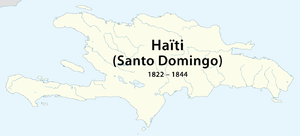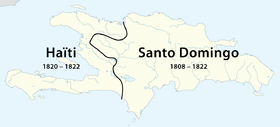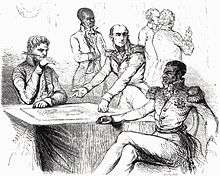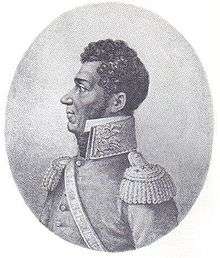Republic of Haiti (1820–1849)
The Republic of Haiti (French: République d’Haïti, Haitian Creole: Repiblik d Ayiti) from 1820 to 1849 was effectively a continuation of the first Republic of Haiti that had been in control of the south of what is now Haiti since 1806. This period of Haitian history commenced with the fall of the Kingdom of Haiti in the north and the reunification of Haiti in 1820 under Jean-Pierre Boyer. This period also encompassed Haitian occupation of Santo Domingo from 1822 to 1844 creating a unified political entity on the island of Hispaniola. Although termed a republic, this period of was dominated by Boyer's authoritarian rule as president-for-life until 1843. The first Republic of Haiti ended in 1849 when president Faustin Soulouque declared himself emperor, thus beginning the Second Empire of Haiti.
Republic of Haiti République d’Haïti Repiblik d Ayiti | |||||||||||||||
|---|---|---|---|---|---|---|---|---|---|---|---|---|---|---|---|
| 1820–1849 | |||||||||||||||
 Maximum extent of the Republic of Haiti from 1822 to 1844 | |||||||||||||||
| Capital | Port-au-Prince | ||||||||||||||
| Common languages | French Spanish Haitian Creole | ||||||||||||||
| Government | Republic (de jure) Dictatorship (de facto) | ||||||||||||||
| President | |||||||||||||||
• 1820–1843 (first) | Jean-Pierre Boyer | ||||||||||||||
• 1847–1849 (last) | Faustin Soulouque | ||||||||||||||
| Historical era | 19th century | ||||||||||||||
• Reunification of North and South Haiti | October 18 1820 | ||||||||||||||
| February 9 1822 | |||||||||||||||
| February 27 1844 | |||||||||||||||
• Proclamation of President Faustin Soulouque as Emperor Faustin I | August 26 1849 | ||||||||||||||
| Area | |||||||||||||||
| 76,480 km2 (29,530 sq mi) | |||||||||||||||
| Currency | Gourde (HTG) | ||||||||||||||
| ISO 3166 code | HT | ||||||||||||||
| |||||||||||||||
| Today part of | |||||||||||||||
Background
After the assassination of the Emperor Dessalines in 1806, the First Empire of Haiti collapsed and was divided in two between former generals of Dessalines.[1]
Initially, Henri Christophe was elected president with limited powers. After Christophe attempted to exert greater power, he ran up against the newly established Senate under Alexandre Pétion who defended the capital of Port-au-Prince. Christophe consolidated power in Cap-Haitien, in the north, and established the State of Haiti before declaring himself president-for-life in 1807. In the south, the Senate elected Pétion as President of the first Republic of Haiti. The two Haitis entered a stalemate between the State of Haiti in the north and the Republic of Haiti in the south. In 1811, the State of Haiti became the Kingdom of Haiti when Christophe declared himself King of Haiti.[2]
Pétion, through control of the Senate, declared himself president-for-life of the Republic of Haiti in 1816. On March 29, 1818, Pétion died and the title of president-for life passed to the commander of his guard, Jean-Pierre Boyer, won the gained support of the Senate. In the northern Kingdom of Haiti, Christophe suffered a severe stroke August 15, 1820 that left him partially paralyzed. Within weeks, dissent was cultivating in the Kingdom and Boyer used the opportunity to begin a march north with the Republic of Haiti's army. Abandoned by his guard and expecting the inevitable insurrection, on October 7, 1820, Christophe killed himself by gunshot. Boyer arrived in Cap-Haitien on October 20, 1820, and formally united the two Haitis into the Republic of Haiti without any further hostilities.[1]
History

Unification of Hispaniola
In the eastern part of Hispaniola, José Núñez de Cáceres declared the independence of the colony as the Republic of Spanish Haiti on December 1, 1821, and applied for admission to the Republic of Gran Colombia. Nine weeks later, Haitian forces led by Jean-Pierre Boyer entered the newly-declared state and occupied Santo Domingo on February 9, 1822.[3] The military occupation of Santo Domingo would last 22 years, until the fall of Boyer.
Reign of Boyer

After the annexation of Spanish Haiti, Boyer took full powers with the title of “Supreme Chief of the Nation” with the right to choose his successor.
In the two decades years that had followed the Haitian Revolution and the expulsion of the French colonial government in 1804, Haiti's de facto independence had not been recognized by the world powers. In 1825, King Charles X of France decreed that his nation was to be compensated 150 million gold francs payable in five years in exchange for recognition of Haitian independence.[4] Under threat of invasion, Boyer agreed and by 1826 Haiti was recognized by almost all world powers with the exception of the United States of America. In order to keep up with the payments committed to France, Boyer had to implement a special tax and negotiate a loan of 30 million to a French bank with an interest rate of 6%, while asking for a reduction of the debt. Charles X also demanded a 50% reduction in customs duties for products exported to France. The debt was reduced to 600 million payable in thirty years, in February 1838.[2] During Boyer's reign, Haiti's economy shifted from primarily sugarcane to primarily coffee exports.

Boyer and his ministers, Jérôme-Maximilien Borgella and Jonathas Granville, were deeply involved in the mass migration of black Americans to Haiti. Loring D. Dewey of the American Colonization Society (ACS) had been an advocate of former slave migration of the United States to Haiti, as opposed to the more common ACS strategy of repatriating black Americans to Liberia. From September 1824, nearly 6,000 Americans, mainly people of free color, emigrated to Haiti in the space of a year. Due to the island's poverty and the Boyer administration's inability to help support new immigrants in transition, most of the resettled black Americans returned to the United States in a short period of time.[5]
Fall of Boyer
Boyer's authoritarian measures eventually lead to a loss of popular support in and in 1842 an insurgency arose in Praslin, not far from Les Cayes, headed by General Charles Rivière-Hérard. Boyer attempted to quell the revolt, but with a loss of support and no chance of victory, Boyer abdicated in 1843 and went into exile in Jamaica.[1]
Return to Republic
Charles Rivière-Hérard would declare him self president-for life but his reign would only last until May 1844. In the month's following Boyer's departure, Santo Domingo took advantage of the chaotic political situation by expelling the Haitian military from the eastern portion of Hispaniola in 1844 during the Dominican War of Independence. During the final five years of the Republic of Haiti, the country would be limited again to the western portion of the island and no longer control the Spanish (now Dominican) side of the island. Following Rivière-Hérard, there would be four more presidents of the Republic of Haiti until Faustin Soulouque was elected president-for-life in 1847.[1]
End of the Republic
On August 25, 1849, Soulouque was proclaimed Emperor of Haiti and the first Republic of Haiti was dissolved. At his coronation ceremony on April 18, 1852, Soulouque become Emperor Faustin I. The Emperor created a new class nobility to surround himself with and began a period of Haitian history known as the Second Haitian Empire.
See also
References
- Robert Heinl (1996). Written in Blood: The Story of the Haitian People, 1492–1995. Lantham, Maryland: University Press of America.CS1 maint: ref=harv (link)
- Bryan, Patrick E. (1984). The Haitian Revolution and Its Effects. Heinemann. ISBN 9780435983017.
- ""Boyer Invades Eastern Hispaniola" by Juan Camilo Vera". islandluminous.fiu.edu. Retrieved 2019-06-15.
- "Jean-Pierre Boyer". Encyclopaedia Britannica. Retrieved 24 May 2020.
- Hidalgo, Dennis (2003). "From North America to Hispaniola: first free black emigration and settlements in Hispaniola". Retrieved 24 May 2020.
.svg.png)
